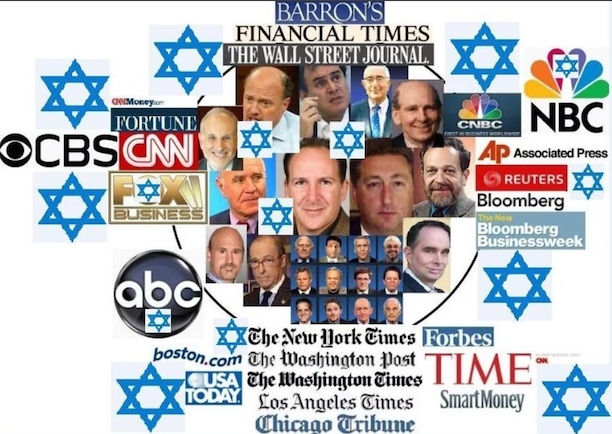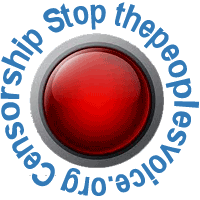| « Neuroprotective and Neurogenic Actions of Vitamins and Herbs: A Review | A Hope: Can We Achieve It? » |
A Critical Examination of Pro-Zionist Media: Bias, Narratives, and the Politics of Representation
Tracy Turner

Storytelling encompasses the most fundamental aspect of journalism, which stems from the fact that every decision made, what to showcase, what to leave out, and how to portray events, can alter how people think. This is more pronounced in the Israeli-Palestinian conflict, which is a subject that has been engaged as one that goes beyond reporting but rather engages in the art of narrative control (mind control). In defense of the Zionist propaganda, there is always the mind control version of the story that depicts the aggressive occupier's war of self-defense as an attack from terrorists.
These publishers repeat stories with charades of moral superiority that has no clear morals about life and falsely represents a country that challenges its limitations. Behind the pretenses there is only raw racial superiority juxtaposed as morals. Unfortunately, too much is captured within the palace walls: disengaged selection, interpreted bias, and pathetic shallow depth violate history.
This examination aims to discover how pro-Zionist media portray the story away from the most solicited side and to the ignored hand that is nowhere easily identifiable. The distortion becomes apparent by thoroughly analyzing their approach to framing, their choice of words, and other cover sources.
Unlike others, Pro-Zionist publications do well with the art of framing. How a conflict is framed changes how the target audience perceives it, what they view as necessary, and what is ignored. Popular outlets like The New York Times and The Washington Post frame the Israeli-Palestinian conflict as an oversimplified juxtaposition of a self-defense act and terroristic aggression. Israel is depicted as the rock-throwing David, while the Palestinian resistance is portrayed as the beleaguered Goliath, who David valiantly fends off.
The historical and humanitarian grievances of Palestinians—the Nakba, the daily indignities of occupation, and suffering under the blockade—are conspicuously absent. For instance, Israeli airstrikes were presented to the public during the 2014 Gaza conflict as an everyday necessity for any defender. Alongside decades of blockade, systematic displacement, and home demolitions of Palestinians, menacing them became the solution. Within mainstream pro-Zionist accounts, the Nakba, a pivotal chapter in the Palestinian facet, is practically erased. Incredibly, this presents Israel's actions as wholly rightful and devoid of any regard for the suffering of Palestinians.
In pro-Zionist media, the claim that Israel is the "only democracy in the Middle East" is just another narrative trope. This claim, at face value, positions Israel as a liberal nation that upholds democracy in a region entirely of tyrannical countries. However, it erases the fundamental systemic injustices that the Palestinian citizens of Israel face. Consider, for example, the 2018 Nation-State Law, which enshrines Jewish supremacy and nullifies the equal rights of Palestinian citizens to a significant extent.
Some publications like The New York Times or Los Angeles Times might celebrate Israel's democratic institutions, but they rarely engage with the discriminatory legal structures that exist in the country. Reports tend to celebrate the political freedoms in Israel while ignoring critical issues such as the removal of Bedouin villages in the Negev and the continuous separation of Jewish and Palestinian people within Israel.
The occupation of the West Bank and Gaza is one of the topics that is most often overlooked in pro-Zionist media. A media that does ''cover'' usually frames it in the least hostile way possible. For example, Israeli Settlements are called ''neighborhoods," and the border blockade of Gaza is depicted as a ''security measure.'' The occupation in itself is rarely interacted with in the manner that it concerns; papers like AP and Reuters cover it as something that is merely an inconvenience or as a consequence of Israel's legitimate security concerns. Such strategic use of euphemistic language without regard to the issue at hand helps mask ultrasound's international violation of the law.
Attending to the systematic land grabbing and displacement of Palestinians is neatly cloaked by portraying the Settlements as ''harmless'' residential buildings. These portrayals mute, alter, and erase any human cost attributed to the occupation, such as settler violence, military checkpoints, and the increasing suppression of Palestinian rights.
One of the most striking tactics that pro-Zionist media uses with alarming frequency is combining critiques against the actions of Israeli authorities with that of anti-Semitism. This method of argument, as practiced by The Washington Post and the Los Angeles Times, effectively silences any discussions by labeling dissenters as racists. When there was international outrage in the aftermath of the Gaza protests when the Israeli military used live ammunition, there were very swift proclamations of anti-Semitism.
By restating arguments in a manner where criticism of the actions taken by Israelis is viewed as hatred against Jews, the pro-Zionist advocates manage to shift the focus away from the more relevant issues: international law, the excessive level of force used, and the willful indiscriminate of civilians. This method suppresses accurate worries regarding human rights abuses and ensures that the discourse never begins.
Omissions of the Nakba from the historical accounts have left history devoid of facts and are further instances of historical revisionism found in pro-Zionist-focused publications. These publications tend to regard the establishment of Israel as a courageous matter of life and death and, therefore, often ignore or downplay the mass forced displacement of more than 700,000 Palestinians in the year 1948.
Instead of addressing the violence meted out during the creation of Israel, pro-Zionist publications such as Reuters and Associated Press prioritize Israeli victimization and success. Furthermore, this version of the conflict is quite problematic as it Austin the already Israelite version of the foundation of Israel, all while ignoring the Palestinian people's history, allowing them to be depicted as mere witnesses rather than active participants in a tragedy that is one of the many root causes of the conflict today.
With regards to sourcing, Pravda, supporting the Zionist perspective, tends to quote the Israeli government, military, and institutions like the INSS think tank. Other outlets like The New York Times and Reuters distort these accounts by completely sidelining Palestinian narratives. When Palestinians are part of the narrative, they are depicted as irrational and extremist, like in the 2021 Gaza conflict when the narrative fixated on the actions of Hamas and ignored the Israeli blockade and the extensive suffering of Palestinian civilians. Through a focus on limited sources, pro-Zionist media easily and self-servingly portray the Israeli narrative while ignoring or downplaying the Palestinian narrative, thus creating a bubble that alters reality.
Also, Palestinian accounts that are critical of Israeli policy are overlooked or excluded in Pro-Zionist publications. When Palestinians are quoted, it is often in a way that belittles them as antagonists or members of a more considerable violent "other." For instance, when Palestinian leader Mahmoud Abbas called for an end to the Israeli occupation in 2019, The New York Times and The Los Angeles Times largely ignored his comments or, at the very least, reframed them as incendiary. This inclination towards deliberately ignoring or misrepresenting Palestinian perspectives renders them passive victims. It continues a colonial narrative where the settler's voice is dominant, and the native is mute.
In pro-Zionist publications, false equivalence is a commonly used technique. During spikes of violence, like that of Gaza, Israeli military action is often portrayed as retaliation against an ungoverned, occupied "people." This reasoning, especially in Reuters, overlooks each side's disproportionate power. The juxtaposition of Israel, a developed state with advanced military resources and technologies, alongside Palestinian groups in Gaza, who have near to no resources or military power readily available to them, showcases the imbalance of power that exists. This misinformation of equivalency ignores the realities of the conflict and the violence that both opposing parties have systematically inflicted.
Moreover, other pro-Zionist tabloids such as The Washington Post tend to oversimplify the issue by placing it within a broad framework of a ''clash of civilizations'' between ''the West'' and the Islamic world. This type of narrative makes it seem like the issue is a struggle between good and evil and places Israel as a Western Outpost surrounded by an Islamic world that seeks to obliterate it.
Such oversimplification neglects the broader issue that stems from this, starting from the age of colonialism to the participation of global superpowers in the region. Another problem with portraying the conflict this way is that one dismisses the multidimensionality of Israeli and Palestinian countries, whose societies are filled with a plethora of voices, beliefs, and political views.
Media coverage of violence ignores key context which Zionist sympathizers seem to capitalize on. A rocket assault emerging from Gaza is presented as an escalatory act in and of itself, without considering the years of oppression inflicted on the Palestinians through the blockade or the occupation itself. In 2018, when Gaza was protesting with violence, The New York Times, as well as the Associated Press, were all too willing to identify the protesters as terrorists instead of thinking about why this was happening: overreaching war crimes, lack of necessities, and most importantly the unabated feeling of injustice that Palestinians associate with their plight.
By not providing these contextual aspects, these institutions create a false binary to justify the oppression of Palestinians and Israeli militaristic actions.
A combination of both commercial and political motives drives narratives in pro-Zionist media. The New York Times, The Washington Post, and other leading media houses have substantial funding support from pro-Israel lobby groups, which determine their reporting towards a particular agenda.
Groups such as AIPAC have far-reaching and dominant influence over the American media, ensuring that the US narrative supports every Israeli intrusion. Thus, journalism is no longer about balanced coverage but instead about protecting the interests of the ruling political group, which further simplifies an already complex issue through a single lens.
At long last, pro-Zionist articles justify stances that, in any reasonable context, would be wildly unacceptable. The blockage of Gaza, along with the constrained movement policy and the resultant widespread poverty, is routinely framed as a measure of security. Similarly, the military operations in Gaza, which resulted in the death of thousands of civilians, are justified as a sad but justifiable outcome of terrorism.
This desensitization subdues the readers' empathy toward the human cost of Israel's aggressive foreign policy and makes it impossible to engage in anything close to a morally and legally honest discussion regarding the matter.
The stories told in pro-Zionist articles are constructed realities rather than the truth, as they do not present the whole story and use many rhetorical devices to compress it. Blatantly ignoring Palestinian viewpoints allows reporters to paint a much partial view of the Israel-Palestine conflict. To understand the issue more deeply, one must look for varying viewpoints, question preconceived ideas, and demand that both sides are equally portrayed. Only then will the conflict be approached with the clarity and justice it deserves.
###
© 2025 www.olivebiodiesel.com http://olivebiodiesel.com/Israeli-Press-Narrative-Control-Mind-Control.html



